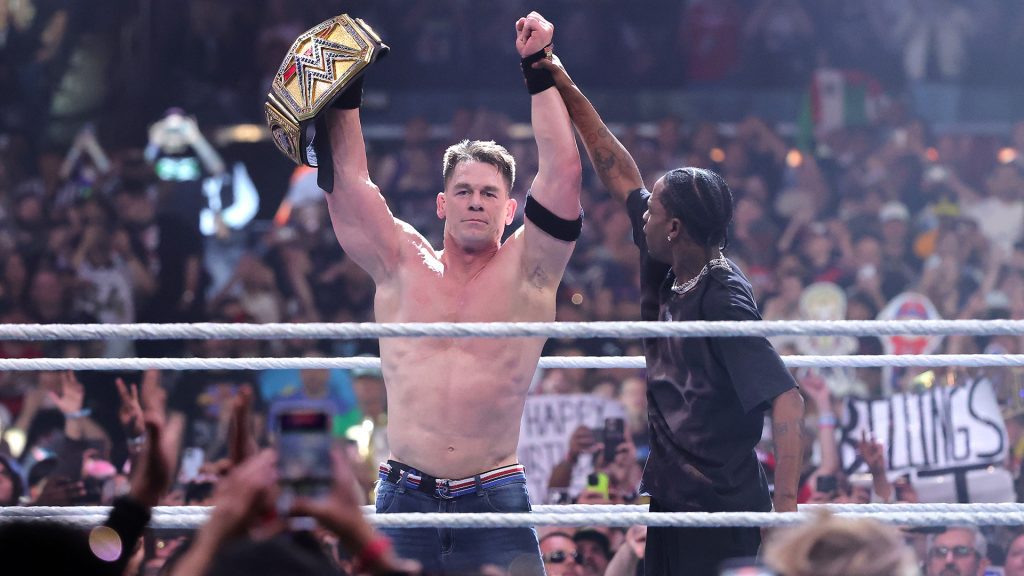In the WWE’s distinctive style, numerous archetypes exist, but none are as quintessential—or, at times, as overused—as the WWE Epic Main Event (EME). While you can identify an EME when you see one, it’s straightforward to dissect it into its key elements. An EME features numerous cinematic moments, often incorporating weapons and the surrounding environment, with tables being the most common. The pace tends to be deliberate, either to build suspense or due to the methodical nature of WWE’s top talent. Crucially for WrestleMania 41‘s dual main events, these matches typically involve excessive outside interference and elaborate mechanics that complicate the basic premise of wrestling—a contest to determine the best performer. The Epic Main Event thrives on WWE’s long-standing distrust that a simple wrestling match is sufficient.
Given this context, the two main events of the two-night WrestleMania 41 understandably followed the Epic Main Event template. Together, they encapsulated the strengths and weaknesses inherent in this style. If last year’s Night 2 main event exemplified WWE’s most indulgent excesses, this year offered a balanced blend of melodrama, with moments that succeeded gracefully and instances that fell flat.
Let’s delve into Night 1, which was clearly the more impressive match and spectacle. Typically, WrestleMania main events feature one of the company’s main titles, usually the men’s world championship. However, this year’s Saturday night finale had low stakes but high drama, featuring a triple threat match with Roman Reigns, Seth Rollins, and CM Punk, who was making his inaugural WrestleMania main event appearance. Punk’s return after nearly a decade away added significant weight to the match’s story and presentation; while Reigns and Rollins received traditional grand entrances, Punk was introduced through a compelling video montage paired with his previous theme music “This Fire” by Killswitch Engage, culminating with a live performance of his current theme “Cult of Personality” by Living Colour, which added to the atmosphere.
Once the match commenced, it adhered to the familiar formula of WWE-style triple threats. The action unfolded with a lot of brawling outside the ring, incorporating spots where one participant was taken out to allow for a brief one-on-one encounter between the other two. The match featured two significant table spots, while the storylines interplayed perfectly; Reigns and Rollins have a decade-long feud, and Punk’s motives revolved around his relationship with Paul Heyman, a pivotal figure in all three wrestlers’ careers. The climax integrated both narratives seamlessly, showcasing the expertise born from WWE’s rich history.
In stark contrast, Night 2’s main event was marred by its lackluster elements, exemplified by the role of Travis Scott as outside interference. The match positioned Cody Rhodes, last year’s main event winner, against John Cena, who had announced it would be his final match, adopting a heel role. Cena entered the ring with an overtly antagonistic demeanor, abandoning his trademark upbeat persona. However, the match’s problems began with this shift, as Cena opted for a slow, calculated approach rather than traditional exciting sequences, to the crowd’s annoyance. The anticipated comeback from Rhodes never materialized, and instead, fans experienced an interruption from Scott, who disrupted the flow and distracted Rhodes, leading to an underwhelming finish with Cena’s 17th title win, breaking the record for most world titles in WWE history.
The core issue was that Paul Heyman was an integral part of Night 1’s storyline, serving a purpose within the match, while Travis Scott felt like an unnecessary addition in Night 2. WWE’s push for viral moments can backfire when it jeopardizes coherent storytelling. This strategy might attract viewers like fans of Travis Scott, but it undermines what makes WrestleMania significant and appealing, especially to those who tune in annually.
In this regard, Night 2 represented a regression in WWE’s storytelling approach compared to the fulfilling action of Night 1, which showcased three prominent wrestlers engaged in a well-crafted narrative that both resolved ongoing conflicts and suggested future plotlines. Meanwhile, Night 2’s focus on creating viral moments, such as Cena’s historic win overshadowed by Scott’s presence, highlighted WWE’s flawed decision-making. Ultimately, while the enduring image should have been Cena celebrating his achievement, it was muddled by the unneeded interference that detracted from the pure storytelling essence wrestling thrives on during its biggest event of the year.



